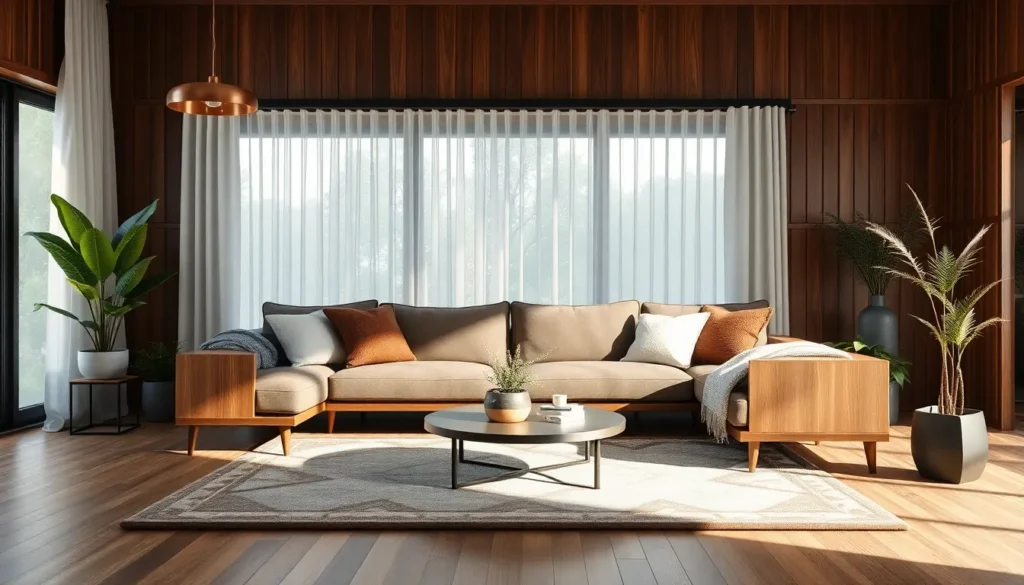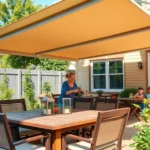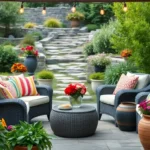We’re obsessed with the timeless appeal of mid-century modern design, and there’s no better place to showcase this iconic style than in your living room. From sleek furniture lines to bold geometric patterns, mid-century modern interiors bring a perfect blend of sophistication and comfort that never goes out of style.
The beauty of mid-century modern living rooms lies in their clean aesthetic and functional approach to design. We’ll show you how to incorporate signature elements like low-profile furniture, rich wood tones, and statement lighting that defined the 1950s and 60s era while keeping your space fresh and contemporary.
Whether you’re starting from scratch or looking to update your current space, we’ve gathered the most inspiring mid-century modern living room ideas that’ll transform your home into a stylish retreat. Get ready to discover how simple changes can create that coveted designer look you’ve been dreaming about.
Choose the Perfect Mid Century Modern Color Palette
We’ve found that selecting the right colors transforms any living room into an authentic mid century modern masterpiece. The era’s distinctive palette creates that perfect balance between warmth and sophistication we’re all seeking.
Embrace Warm Earth Tones and Natural Hues
Rich walnut browns serve as the foundation for our mid century modern color schemes, echoing the wood furniture that defines this style. We recommend starting with warm beiges like mushroom or oatmeal on walls, which create a cozy backdrop without overwhelming the space.
Burnt orange and rust tones add the perfect amount of warmth through throw pillows, artwork, or accent chairs. These colors appeared frequently in 1950s and 60s interiors, bringing that authentic vintage feel we’re aiming for.
Deep forest greens work beautifully as accent colors, especially when paired with brass fixtures or wooden elements. We’ve seen olive and sage green create stunning focal points through large furniture pieces like sofas or credenzas.
Cream and off white shades keep spaces feeling open and bright while maintaining the era’s sophisticated aesthetic. These neutral tones allow bolder elements like geometric patterns or statement lighting to shine.
Incorporate Bold Accent Colors Strategically
Vibrant turquoise creates stunning contrast against warm wood tones, making it perfect for ceramic vases, throw blankets, or artwork. We suggest using this color sparingly to maintain the sophisticated balance that defines mid century modern design.
Sunny yellow brings cheerful energy through decorative accessories like lamps, cushions, or bar carts. This color works particularly well in rooms with plenty of natural light, improving the airy feel that’s essential to the style.
Bold geometric patterns in black and white add visual interest without competing with your main color palette. We recommend incorporating these through area rugs, wallpaper, or fabric choices to create ever-changing focal points.
Coral pink offers a softer alternative to orange while still maintaining that retro appeal we associate with the era. This shade works beautifully in smaller doses through ceramics, textiles, or wall art.
Select Iconic Mid Century Modern Furniture Pieces
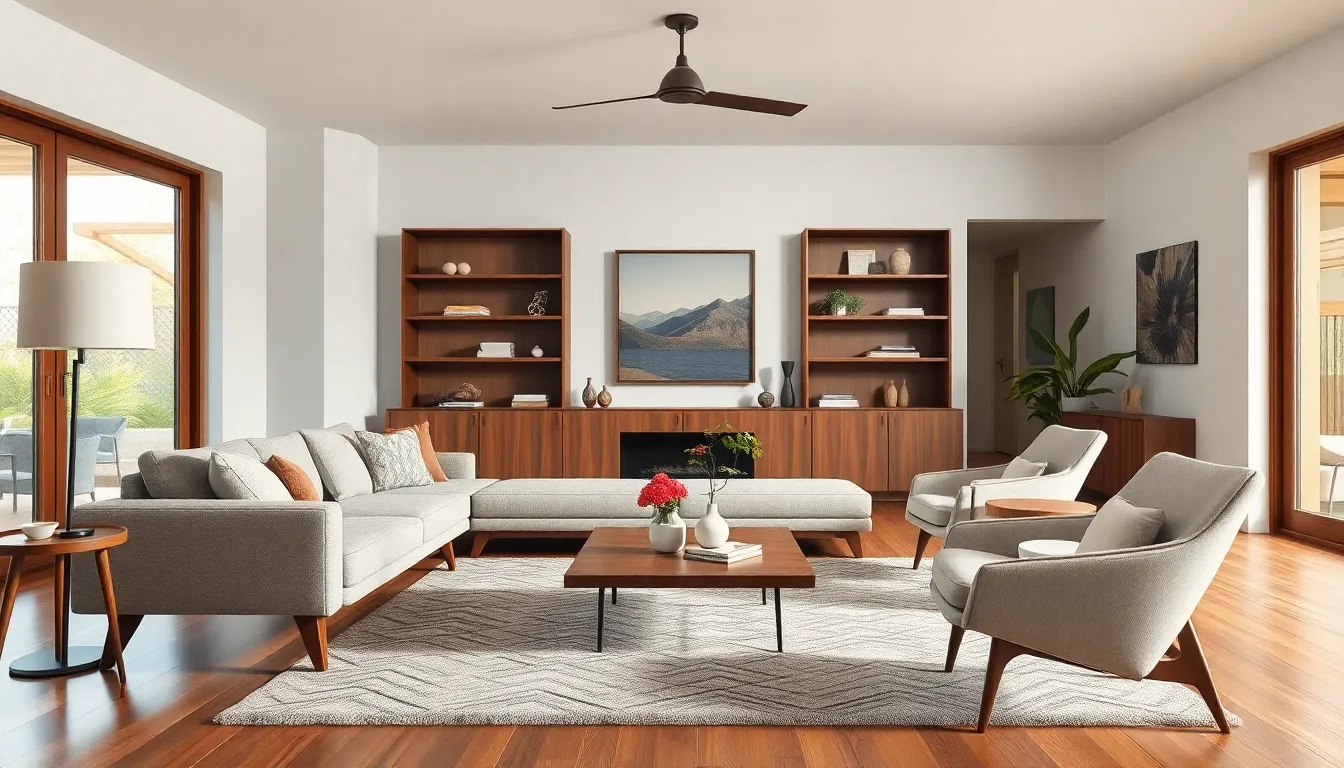
We’ll now focus on the furniture pieces that define authentic mid century modern style. These iconic designs by legends like Charles and Ray Eames, Eero Saarinen, and George Nelson combine clean lines with organic curves while maintaining the perfect balance of form and function.
Invest in a Statement Sofa with Clean Lines
Statement sofas anchor mid century modern living rooms with their distinctive low profiles and tapered legs. We recommend looking for modular designs that feature straight lines and minimal ornamentation, as these characteristics define the authentic retro aesthetic. The Togo sofa by Michel Ducaroy exemplifies this approach with its sculptural form and contemporary comfort features.
Contemporary interpretations of classic designs offer the same visual impact while meeting modern living needs. Sofas with walnut wood frames and neutral upholstery create the perfect foundation for your color palette. Low sitting heights and wide proportions make these pieces both stylish and practical for entertaining guests.
Add Low Profile Coffee Tables and Side Tables
Coffee tables in mid century modern spaces sit close to the ground and feature geometric shapes that complement the room’s clean aesthetic. We suggest choosing oval, circular, or rectangular designs crafted from materials like walnut, glass, or metal combinations. These low profile pieces create an open and airy atmosphere while providing essential functionality.
Side tables should echo the same design principles with their streamlined silhouettes and quality materials. Wooden finishes in rich walnut tones work particularly well alongside glass tops for visual lightness. Multiple small tables offer more flexibility than single large pieces, allowing you to rearrange your space as needed.
Include Sculptural Lounge Chairs
Sculptural lounge chairs serve as both focal points and conversation pieces in authentic mid century modern interiors. We recommend investing in iconic designs like the Eames lounge chair, Arne Jacobsen’s Egg chair, or the Swan chair for their bold silhouettes and lasting comfort. These pieces combine visual drama with ergonomic design principles that remain relevant today.
Positioning becomes crucial when incorporating these statement chairs into your layout. Place sculptural seating at angles to create interesting sight lines while ensuring they complement rather than compete with your sofa. Rich leather upholstery or bold fabric choices can tie these pieces into your overall color scheme while maintaining their individual character.
Create Focal Points with Geometric Patterns and Textures
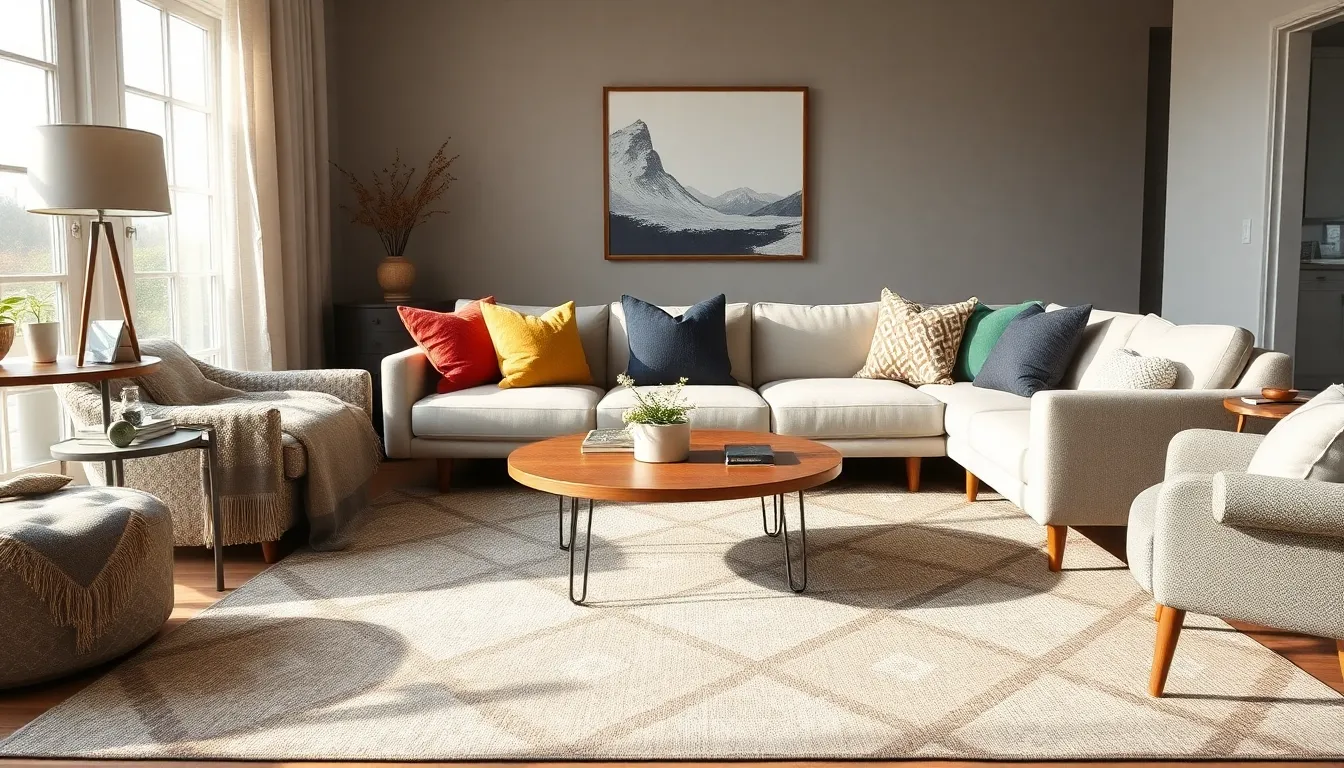
Building upon our carefully chosen color palette and iconic furniture pieces, we can now transform the living room through strategic use of geometric patterns and layered textures that define mid-century modern aesthetics.
Layer Bold Geometric Rugs
Geometric rugs serve as the room’s centerpiece, offering a retro vibe while allowing other design elements to harmonize without overwhelming the senses. We recommend selecting large scale patterns in neutral tones like charcoal gray, cream, and walnut brown to complement our established color scheme. Bold designs featuring diamonds, chevrons, or atomic starburst motifs instantly ground the space and reinforce the mid-century motif.
Position your geometric rug to anchor the seating area, ensuring it extends beyond the front legs of sofas and chairs. Vibrant tones in burnt orange or turquoise can energize neutral spaces, while monochromatic patterns in black and white create sophisticated visual interest. The combination of geometric shapes with varying scales helps tie together furniture and accent pieces throughout the room.
Consider layering smaller accent rugs over larger neutral bases to add depth and define separate conversation areas within open floor plans. This technique allows us to experiment with bolder patterns while maintaining visual balance in larger living spaces.
Mix Textured Throw Pillows and Blankets
Textured throw pillows enhance comfort and visual appeal when paired with mid-century sofas and chairs, providing softness that offsets the angular lines of our furniture. We suggest mixing materials like velvet, wool, boucle, and patterned fabrics in complementary shapes and sizes. Pillows in varied textures create tactile interest while maintaining the clean aesthetic.
Layer throws in complementary textures to amplify the inviting, curated look characteristic of mid-century modern interiors. Alpaca wool blankets, mohair throws, and woven cotton pieces add warmth without compromising the sleek silhouette of low profile seating. The strategic placement of textiles softens hard surfaces while introducing subtle pattern variations.
Combine smooth and nubby textures through materials like leather accent pillows, plaid wool throws, and brushed cotton covers. This textural contrast adds depth and warmth while maintaining the classic mid-century look that seamlessly blends indoor and outdoor living concepts.
Incorporate Natural Materials and Finishes
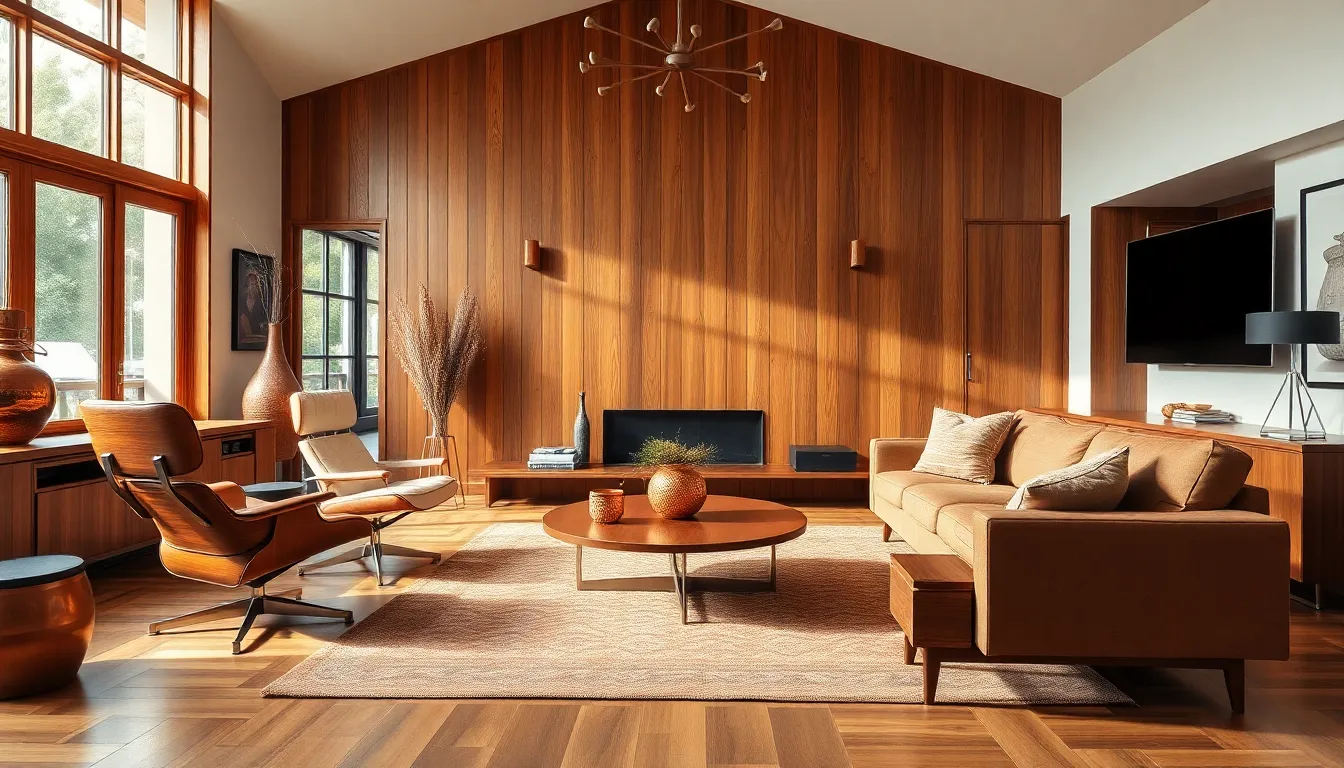
Natural materials form the foundation of authentic mid-century modern design, creating that seamless indoor-outdoor connection that defines the era.
Feature Rich Wood Tones Throughout the Space
Embrace wooden wall paneling to instantly transform your living room into a warm mid-century haven. Oak and walnut finishes deliver the most authentic look, with darker wood tones creating an especially cozy atmosphere that complements your geometric patterns and textured elements.
Select iconic furniture pieces that showcase rich wood craftsmanship, such as the timeless Eames Lounge Chair or the sculptural Noguchi Coffee Table. These statement pieces anchor your space while displaying the natural wood grain that mid-century designers celebrated.
Install hardwood flooring in natural finishes to create a cohesive foundation throughout your living room. Wood floors in warm tones tie together your furniture pieces and wall treatments, establishing the organic base that makes other design elements shine.
Layer wood accents through smaller decorative pieces like wooden bowls, picture frames, and side tables. Multiple wood tones can coexist beautifully when you maintain similar undertones and vary the scale of each piece.
Add Stone and Metal Accents
Create stone focal points through dramatic features like exposed brick fireplaces or natural stone accent walls. Stone elements add the textural contrast that balances smooth wood surfaces and soft textile layers you’ve already incorporated.
Introduce metal lighting fixtures in bronze or copper finishes to add sophisticated gleam to your natural palette. Pendant lights, floor lamps, and table lamps with metal components create visual punctuation points while maintaining the era’s clean aesthetic.
Combine metal and wood in furniture pieces to achieve that signature mid-century look, such as coffee tables with metal hairpin legs supporting wooden tops. This pairing creates ever-changing tension between industrial and organic elements.
Incorporate metal decorative pieces like copper vases, bronze sculptures, or brass accent bowls to distribute metallic touches throughout your space. These smaller elements tie your stone and metal features together without overwhelming the natural wood foundation.
Design Strategic Lighting Solutions

Effective lighting in mid-century modern living rooms combines both artificial and natural sources to create a balanced and inviting space. Our strategic approach highlights architectural details and furniture pieces while maintaining the open and airy feel that defines this timeless style.
Install Iconic Pendant and Floor Lamps
Sculptural pendant lights with metallic finishes serve as the foundation of authentic mid-century lighting design. We recommend placing a single bold pendant above seating areas or dining spots to create a stunning focal point that draws the eye upward. Bronze and gold accents add warmth without overwhelming the carefully curated color palette we’ve established.
Floor lamps with slim profiles become essential statement pieces that reinforce the era’s design ethos. Tripod and arc shaped designs crafted from brass or wood provide both ambient and task lighting while maintaining the clean lines characteristic of the style. These iconic pieces work beautifully alongside our selected furniture to create visual harmony throughout the space.
Designers consistently recommend choosing lighting fixtures that mirror the organic forms and natural materials we’ve incorporated elsewhere in the room. Metallic finishes in bronze, brass, and copper complement the rich wood tones of our walnut coffee tables and oak flooring perfectly.
Maximize Natural Light with Strategic Window Treatments
Full-length windows and glass doors remain staple features that connect our indoor living spaces to the outdoors seamlessly. We prioritize window treatments that enhance rather than obstruct the natural illumination that floods these expansive openings. Sheer curtains allow sunlight to enter while preserving privacy and maintaining the room’s clean aesthetic.
Light-filtering blinds offer another excellent option for controlling brightness without sacrificing the open atmosphere we’ve created. Simple and unobtrusive treatments in neutral or warm tones work best with our established color palette of earth tones and accent colors. Heavy drapes contradict the mid-century philosophy of bringing nature indoors and should be avoided entirely.
Natural light becomes our primary source of illumination during daylight hours, reducing reliance on artificial sources while highlighting the geometric patterns in our rugs and the rich textures of our throw pillows and blankets.
Arrange Furniture for Optimal Flow and Function
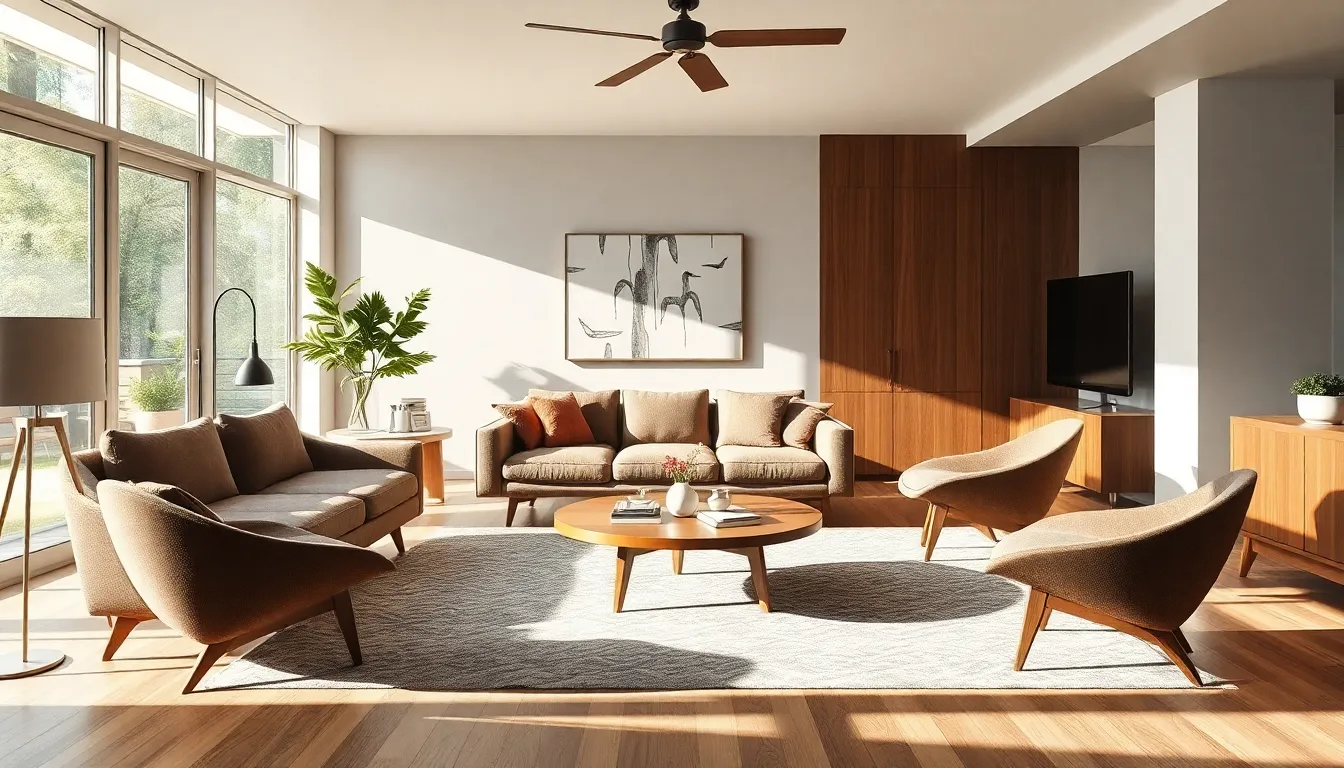
We need to position our mid-century modern pieces strategically to create both beautiful and livable spaces. Modular furniture like the iconic Togo sofa anchors our room while maintaining the flexibility that defines this timeless style.
Create Conversation Areas with Thoughtful Placement
Place sofas and chairs facing each other to foster natural interaction and create intimate gathering spots within larger rooms. We position our seating arrangements in circular or L-shaped configurations that encourage conversation while maintaining the clean lines characteristic of mid-century design.
Select circular or oval coffee tables as centerpieces to promote community and easy movement around our conversation areas. These rounded shapes soften the angular furniture pieces while providing functional surfaces for drinks, books, and decorative objects.
Position furniture pieces at comfortable distances from each other, typically 3-4 feet apart, to allow for easy conversation without shouting across the room. We arrange our iconic mid-century chairs and sofas to create multiple conversation zones in open floor plans.
Guide traffic flow naturally by positioning our modular seating pieces to direct movement through the space without blocking pathways. Corner arrangements work particularly well for creating cozy conversation nooks while preserving the room’s open feel.
Maintain Open Sightlines and Spacious Pathways
Keep pathways clear and unobstructed by positioning furniture away from main traffic routes, allowing natural movement between different areas of our living room. We maintain at least 36 inches of walking space between major furniture pieces to ensure comfortable navigation.
Maximize natural light sources by avoiding furniture placement that blocks windows or architectural features, preserving the indoor-outdoor connection essential to mid-century modern design. Our low-profile furniture pieces help maintain unobstructed views to the outdoors.
Create visual breathing room by leaving adequate space between walls and furniture, preventing the cramped feeling that contradicts mid-century principles of openness. We position our statement pieces like sculptural lounge chairs where they can be appreciated from multiple angles.
Establish clear zones within open floor plans using furniture placement rather than walls, defining distinct areas for relaxation, entertainment, and circulation. Our modular furniture arrangements create natural boundaries while preserving the spacious atmosphere that makes mid-century modern living rooms feel larger than their actual square footage.
Add Mid Century Modern Art and Decorative Elements
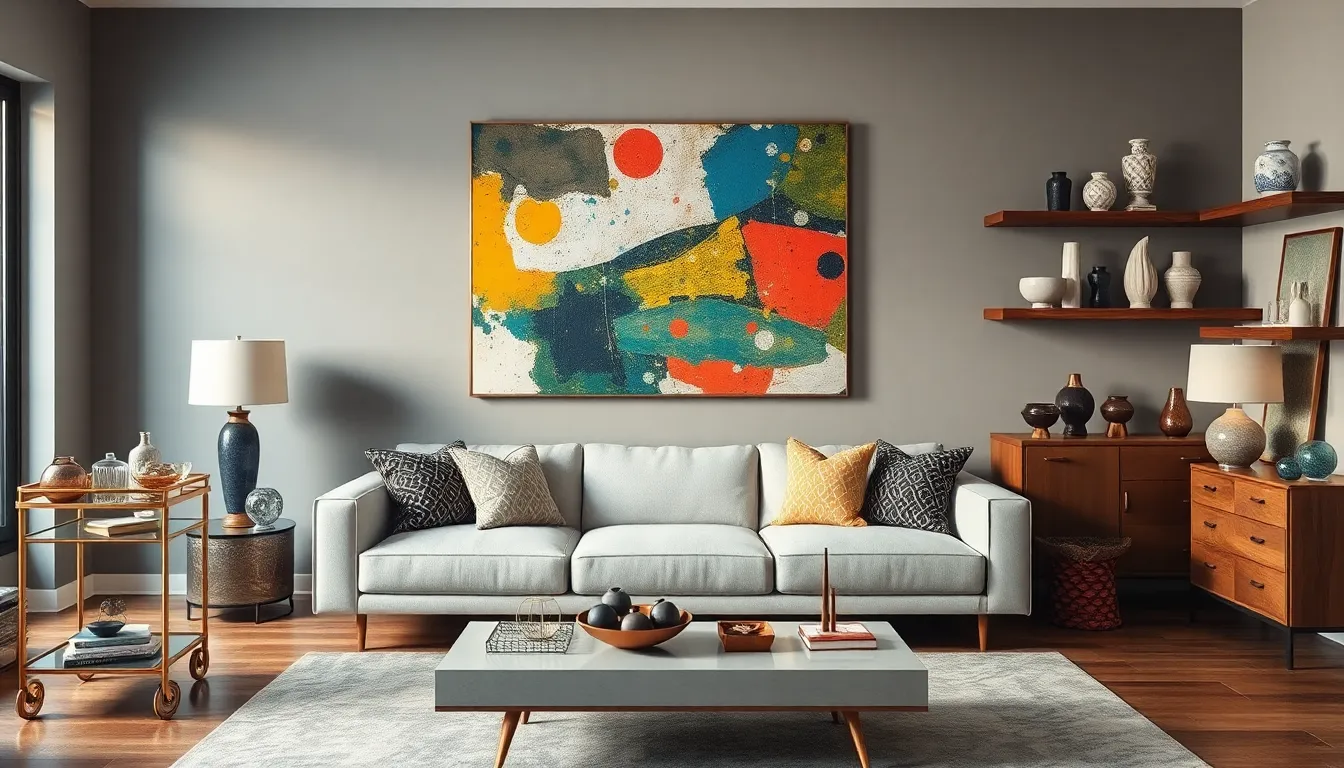
Art and decorative elements complete the mid-century modern aesthetic we’ve been building throughout our living room design. These carefully chosen pieces transform functional furniture arrangements into sophisticated spaces that reflect the era’s bold artistic vision.
Display Abstract and Geometric Artwork
Abstract and geometric artwork serves as the perfect complement to our mid-century modern furniture selections. We recommend positioning large-scale paintings above sofas or mantels to create visual anchors that enhance the room’s sense of space and period authenticity. Bold lines and asymmetrical shapes in vibrant colors define this artistic approach, reflecting the era’s shift toward stylized and expressive forms.
Frame selection matters significantly for achieving authentic mid-century appeal. Natural wood frames in walnut or teak finishes coordinate beautifully with our wooden furniture pieces, while black metal frames provide sleek contrast against lighter wall colors. Minimalist abstract paintings work exceptionally well in this setting, as do geometric prints that echo the clean lines we’ve established throughout the space.
Sculptural wall hangings add dimensional interest beyond traditional framed artwork. Sputnik era lighting fixtures double as artistic elements, while sculptural mobiles create movement and visual intrigue. These three-dimensional pieces enhance the organic shapes and functional design principles that define mid-century modern aesthetics.
Include Vintage Accessories and Sculptures
Vintage accessories bring authentic character to our carefully curated mid-century modern living rooms. Ceramics, metal objects, and glassware displayed on credenzas, bookshelves, or bar carts create focal points that celebrate the era’s craftsmanship. These period pieces should feature clean lines and natural materials that complement our existing wood and metal finishes.
Sculptures provide sculptural interest whether they feature abstract, organic, or figurative designs. We suggest mixing authentic period pieces with contemporary accents to achieve a balanced look that feels both nostalgic and current. Metal sculptures in bronze or copper finishes coordinate with our lighting choices, while ceramic pieces in warm earth tones reinforce our established color palette.
Bar carts emerge as particularly effective display platforms for mid-century accessories. These functional pieces showcase glassware collections, vintage decanters, and small sculptural objects while maintaining the modular and iconic furniture approach we’ve emphasized. Strategic placement of these accessories creates visual rhythm throughout the space without overwhelming the clean aesthetic we’ve developed.
| Element | Description |
|---|---|
| Artwork | Abstract, geometric, bold colors, wood/metal frames |
| Accessories | Ceramics, glass, metal objects displayed on credenzas |
| Sculptures | Abstract, organic, or figurative with clean lines |
| Display Areas | Bar carts, bookshelves, mantels for visual interest |
Integrate Indoor Plants for Organic Appeal
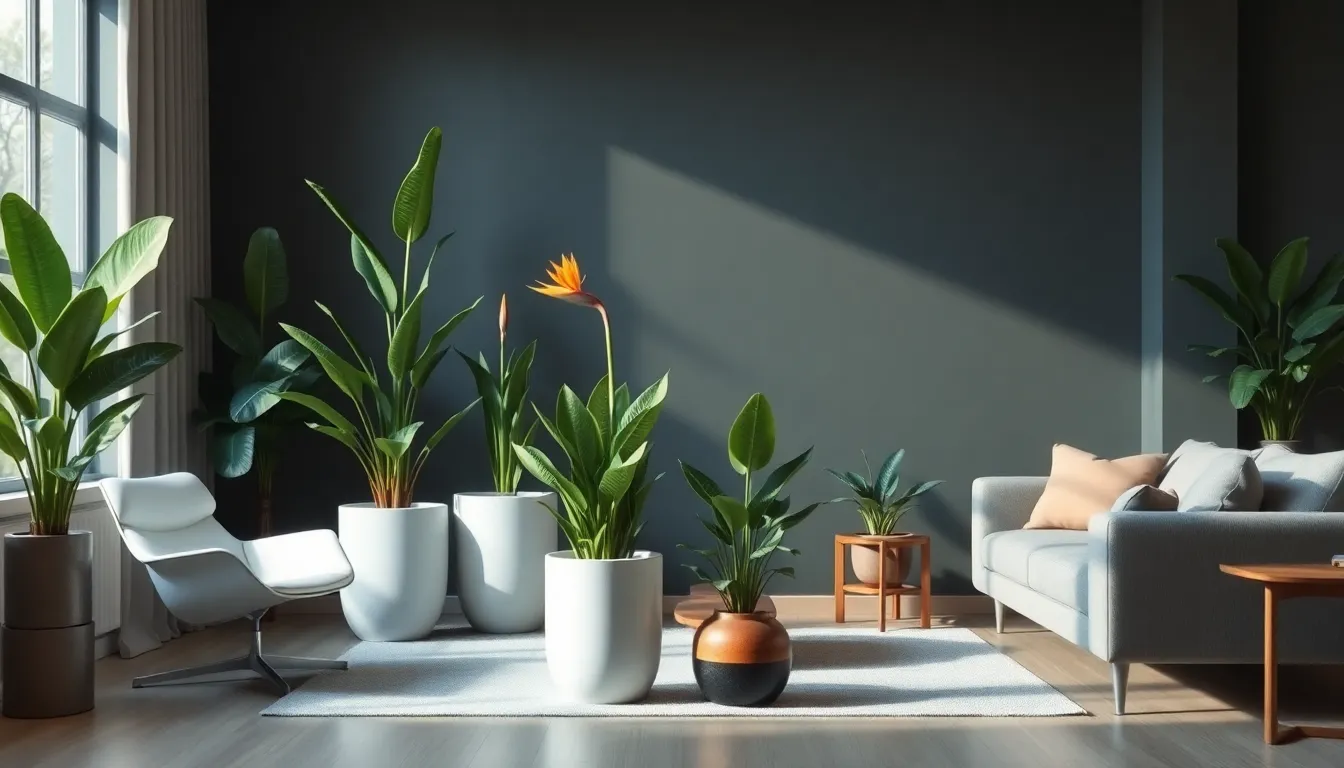
Plants breathe life into mid century modern spaces while reinforcing the style’s inherent connection to nature. We can achieve this organic appeal by selecting the right plants and positioning them strategically throughout our living room.
Choose Architectural Plants in Modern Planters
Selecting plants with strong architectural forms enhances the clean geometry that defines mid century modern design. Bird of Paradise plants offer dramatic height and sculptural leaves that complement low profile furniture pieces perfectly. Dracaena varieties provide striking vertical lines that echo the angular elements we’ve established with our furniture selections.
Pairing these statement plants with geometric planters amplifies their visual impact while maintaining design cohesion. We recommend choosing planters with minimalist silhouettes in materials like ceramic, concrete, or metal that match our existing finishes. Cylindrical and rectangular containers work exceptionally well, as do tapered designs that mirror the era’s iconic furniture legs.
Placing architectural plants near our key furniture pieces creates intentional relationships between organic and manufactured elements. A tall Dracaena positioned beside an Eames lounge chair establishes visual balance, while a Bird of Paradise anchors the corner opposite our modular sofa arrangement.
Create Green Focal Points Throughout the Room
Distributing plants at varying heights establishes visual rhythm that guides the eye naturally through our living space. Large floor plants serve as anchor points in corners or beside major furniture pieces, while medium sized plants on side tables and credenzas create mid level interest. Small plants on floating shelves or our bar cart add delicate touches that complete the layered composition.
Mixing plant textures and colors adds depth without disrupting our carefully curated color palette. Glossy leaved plants like rubber trees complement matte finished ceramics, while silvery succulents echo metallic accents in our lighting fixtures. Deep green foliage reinforces the forest green tones we’ve incorporated throughout the space.
Grouping plants in odd numbers creates more ever-changing arrangements that feel natural rather than symmetrical. We suggest clustering three plants of different heights near our large windows to maximize their connection to outdoor light, or placing a single statement plant opposite a grouping of two smaller varieties to achieve visual balance.
Balance Minimalism with Cozy Comfort
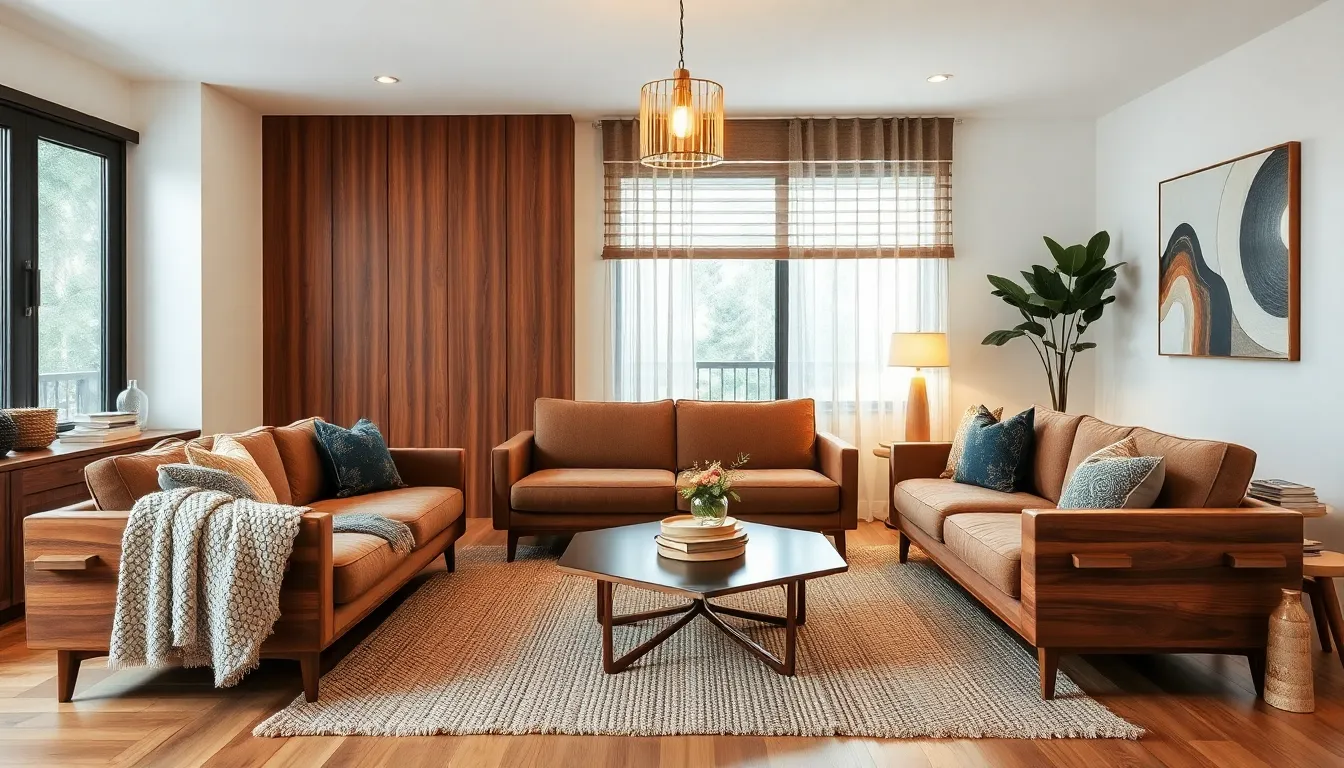
Mid-century modern living rooms excel when they merge clean aesthetics with inviting warmth. We’ll show you how to achieve this perfect balance through strategic design choices.
Avoid Clutter While Maintaining Warmth
Select modular furniture pieces that define spaces without overwhelming your room’s open floor plan. We recommend choosing iconic mid-century designs in warm wood finishes like walnut and neutral tones that bring both style and comfort to your living space.
Maintain clear pathways by positioning a limited number of statement pieces throughout your room. Focus on one modular sofa or geometric coffee table as your anchor, then supplement with simple storage answers that keep surfaces clean and organized.
Incorporate wood paneling to create moody, sophisticated accents that add warmth without visual chaos. Pair these architectural elements with soft textiles, leather upholstery, or curved sofas to ensure your space feels welcoming rather than stark.
Introduce warmth through thoughtful lighting such as sculptural pendant lights in bronze or brass finishes. Layer different light sources while keeping fixtures minimal and purposeful to avoid competing elements in your carefully curated space.
Add pops of color strategically through throw pillows or artwork rather than multiple decorative objects. This approach maintains your room’s uncluttered aesthetic while injecting personality and visual interest through selective color placement.
Layer Textures for Visual Interest
Combine smooth leather surfaces with chunky knit throws to create depth and character in your mid-century modern living room. Mix these contrasting textures on your seating areas to soften angular furniture lines while maintaining the style’s sophisticated appeal.
Incorporate woven rugs alongside burled wood surfaces to establish rich textural variety throughout your space. This combination adds visual engagement while keeping your design uncluttered and true to mid-century modern principles.
Layer different fabric weights using materials like velvet, wool, and boucle in your throw pillows and blankets. Create a curated look that enhances comfort while adding textural dimension to your room’s clean geometric forms.
Mix nubby and smooth textures strategically across furniture and accessories to achieve visual balance. Position textured elements like woven baskets or ceramic vases near sleek surfaces to create interesting contrasts that draw the eye without overwhelming your space.
Combine natural and manufactured materials such as leather upholstery with metal coffee table legs or wood grain against glass surfaces. This approach creates sophisticated layering that feels both modern and timeless while maintaining the uncluttered aesthetic essential to mid-century design.
Conclusion
Creating your dream mid-century modern living room is all about finding the perfect balance between timeless design principles and personal comfort. We’ve shown you how thoughtful planning and strategic choices can transform any space into a sophisticated retreat that honors this iconic design era.
The beauty of mid-century modern style lies in its adaptability – whether you’re working with a complete renovation or simply refreshing your current space. By focusing on quality materials natural elements and clean lines you’ll create a living room that feels both authentic and thoroughly contemporary.
Remember that the most successful mid-century modern spaces tell a story through carefully curated pieces rather than overwhelming displays. Trust your instincts choose elements that speak to you and enjoy the process of creating a space that truly reflects your personal style while celebrating this enduring design legacy.
Frequently Asked Questions
What are the key elements of mid-century modern living room design?
Mid-century modern design features clean lines, low-profile furniture, rich wood tones (especially walnut and oak), and sculptural lighting. The style emphasizes functional design with geometric patterns, natural materials, and a warm earth-tone color palette including browns, beiges, and accent colors like burnt orange and forest green.
What colors work best for a mid-century modern color palette?
Warm earth tones form the foundation: walnut browns and beiges for walls, complemented by burnt orange and rust accents. Deep forest greens work as accent colors, while cream and off-white maintain openness. Bold pops of turquoise, sunny yellow, and coral pink add visual interest alongside geometric black and white patterns.
Which furniture pieces are essential for mid-century modern style?
Statement sofas with clean lines and low profiles anchor the space, preferably in modular designs. Low-profile coffee tables in walnut or glass enhance the airy feel. Sculptural lounge chairs, particularly iconic designs like the Eames Lounge Chair, serve as focal points. All pieces should emphasize both visual drama and ergonomic comfort.
How do you incorporate patterns and textures in mid-century modern design?
Use bold geometric rugs as centerpieces with large-scale patterns in neutral tones and vibrant accents. Layer textured throw pillows and blankets mixing materials like velvet, wool, and boucle. Combine smooth and nubby textures to add depth while softening angular furniture lines and maintaining the classic aesthetic.
What natural materials are important in mid-century modern design?
Rich wood tones like oak and walnut create warmth throughout the space. Hardwood flooring in natural finishes provides a cohesive foundation. Stone accents through exposed brick fireplaces or natural stone walls add textural contrast. Metal elements in bronze or copper finishes complement the wood foundation perfectly.
How should lighting be handled in mid-century modern living rooms?
Combine iconic pendant and floor lamps with sculptural designs and metallic finishes as focal points. Maximize natural light with sheer curtains and light-filtering blinds to maintain the open atmosphere. Balance artificial and natural lighting sources to create an inviting space that connects indoor areas with the outdoors.
What’s the best way to arrange furniture in a mid-century modern living room?
Position modular pieces to create conversation areas while maintaining clean lines and unobstructed sightlines. Use circular or oval coffee tables as centerpieces to promote community and ease movement. Maintain clear pathways and define distinct zones for relaxation and entertainment through thoughtful placement that enhances spaciousness.
How do you choose art and accessories for mid-century modern spaces?
Display abstract and geometric artwork in natural wood or black metal frames to create visual anchors. Select vintage ceramics and metal objects for character. Use sculptures for additional visual interest and bar carts as display platforms. Focus on pieces that enhance authenticity without overwhelming the clean aesthetic.
What role do plants play in mid-century modern design?
Architectural plants like Bird of Paradise and Dracaena paired with geometric planters maintain design cohesion. Strategic placement creates visual balance and rhythm throughout the room. Mix plant textures and colors for depth while respecting the curated color palette. Group plants in odd numbers for natural arrangements.
How do you balance minimalism with comfort in mid-century modern living rooms?
Select modular furniture that defines spaces without cluttering the open floor plan. Focus on statement pieces in warm wood finishes and incorporate thoughtful lighting for warmth. Layer textures by combining smooth leather with chunky knits. Mix natural and manufactured materials to achieve sophisticated yet uncluttered design that feels inviting.

